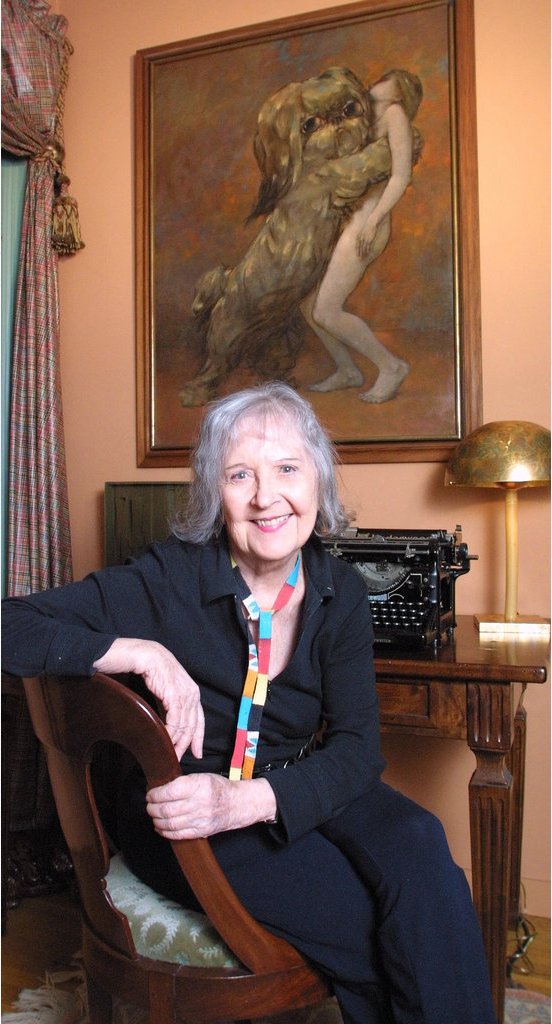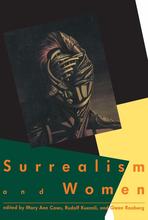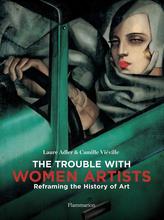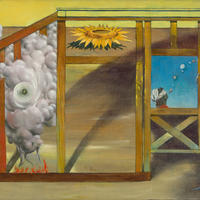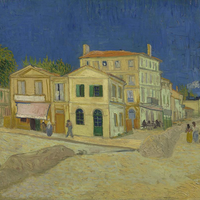More about Dorothea Tanning
- All
- Info
- Shop
Works by Dorothea Tanning
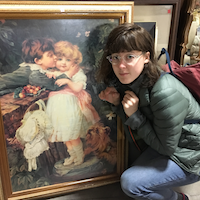
Contributor
One afternoon, while Dorothea Tanning was saying farewells after a visit with Picasso, he suddenly “broke off the last flower from an old rose bush and handed it to [her].”
Picasso was a romantic, but this wasn’t unusual behavior towards Tanning either. She was a beloved member of the Surrealist community—or, as much as a woman could be in that boy's club. Upon her death at 101 years old, she was also the last living member of the movement, but she didn’t appreciate this title; being called a Surrealist in the 21st century made her feel “like a fossil” because Surrealism ended in the '50s and "her work had moved on so much by the '60s." She would have preferred to be called “the oldest living emerging poet,” because even at her late age she blossomed as a successful poet, novelist, and even wrote two autobiographies.
Dorothea Tanning was born to Swedish parents who emigrated to Galesburg, Illinois when Tanning was still young. At twenty-years-old, she moved on her own to Chicago where she recounts going on a date with a gangster who was allegedly called away and murdered while she waited at the bar (possibly the only acceptable reason for ghosting). Eventually, she made her way to New York where she landed at the center of the budding Surrealist movement—as she puts it, "[floating] through antic evenings to the sound of jazz and the tinkling of glasses containing icy drinks." She tried to go to Paris but was deterred by this guy Hitler who was due to invade in three weeks. After fleeing back to New York, Tanning made friends with Julien Levy who owned a New York gallery representing Surrealists. She only had two paintings to show him but it was enough. He took her under his wing immediately.
One day, Max Ernst visited her studio while recruiting artists for an exhibition at his then-wife Peggy Guggenheim’s gallery, Art of this Century. He was so impressed by her self-portrait, Birthday (one of her most famous works to his day), that he convinced Peggy to include Tanning in the exhibition, which would now be called 31 Women instead of 30 Women with the addition of Tanning. Guggenheim understandably regretted the decision because within weeks Ernst had left her to move in with Tanning. The pair married shortly after in a double wedding with Man Ray and Juliet Browner. Peggy Guggenheim, Duchamp, Magritte, Dali, and Picasso were all in attendance.
Sources
- Fernandes, Andréa. “Painter to Poet: Dorothea Tanning.” Mental Floss. http://mentalfloss.com/article/19445/painter-poet-dorothea-tanning (accessed 22 June 2018).
- Wood, Gaby. “I’ve always been perverse.” The Guardian. https://www.theguardian.com/artanddesign/2004/aug/15/art.fiction (accessed 22 June 2018).
- Glassie, John. “Oldest Living Surrealist Tells All.” Salon. https://www.salon.com/2002/02/11/tanning/ (accessed 22 June 2018).

Contributor
If you thought Dali made weird paintings, then you've never met Dorothea Tanning.
Dorothea grew up in Galesburg Illinois, “A place where you sat on the davenport and waited to grow up” her words, not mine. Well growing up she did, into an ambitious and gorgeous young women. Dorothea wanted to become a painter and her parents feared she would become one of those “bohemians." In 1930, she moved to Chicago to attend art school, but dropped out after three weeks. As a true bohemian she eventually moved to New York City. After seeing “Fantastic Art, Dada, Surrealism” at MOMA she had found her true calling, painting super disturbing images!
In 1939, Dorothea went to Paris to meet all of her surrealist heroes, but her timing couldn't have been more off. Most of them had just moved to the US because Europe was on the brink of war. By 1941, she had impressed Julien Levy enough for him to give her two solo shows at his gallery. After meeting Julien she entered the bohemian artists scene, the one her parents feared so much. Soon after, painter Max Ernst dropped by her studio. He was looking for candidates for a “women of surrealism” exhibition he was organizing for his wife’s (Peggy Guggenheim) new gallery. Story goes, he was very impressed with Dorothea's unfinished work Birthday, a half naked self-portrait. Max stayed for some chess playing & chill and the two moved in together two weeks after That must have been some game of chess!
The couple moved to Sedona Arizona and married in a double ceremony with photographer Man Ray and dancer Juliet Browner. Dorothea’s work continued to get more and more attention, but also her paintings became more and more surreal. Ten years later they had to move to France because Max was denied citizenship. The two stayed in France until Max died in 1976. Dorothea decided to go back to NY and completed her move in 1980. Grief inspired her to make more crazy paintings. Much later in life, she started to write and publish poetry, calling herself “the oldest living emerging poet.”

Sr. Contributor
Dorothea Tanning was a small-town girl from Galesburg, Illinois, who had bigger, weirder dreams for herself.
Tanning explored her creativity from an early age, experimenting with painting and writing from the start. She always knew that her painting was a bit on the strange side, but until she discovered Surrealism at a 1936 exhibition at Museum of Modern Artin New York, she didn’t really have a name for the semi-disturbing images she found buried in the back of her psyche. Unfortunately, her family didn’t understand what she was going for, and they found their daughter’s artwork pretty horrifying.
She didn’t let the haters get her down, though. Tanning was born to be a Surrealist. However, when she went to Paris to meet the giants of the art movement, was forced to turn around and go home due to the outbreak of World War II. All of the artists she hoped to meet had fled in the wake of the violence, among them the infamous Max Ernst. Ernst escaped Nazi-occupied France for the United States with the help of Peggy Guggenheim, his fourth wife. Yes, Peggy Guggenheim of the Peggy Guggenheim Collection, collector extraordinaire. Luckily for Tanning, Ernst and Guggenheim landed in New York, so Tanning earned herself an invitation to a bougie party thrown by Julien Levy, the New York gallery owner who showed Surrealist artworks.
After their chance meeting, Ernst and Tanning hit it off, and Ernst even convinced Guggenheim to add Tanning to the exhibition 30 Women, making it 31 Women. Three weeks later, Tanning and Ernst shacked up together and became a Surrealist power couple. Their wedding was actually a double wedding with artist Man Ray and his wife Juliet. Despite being a pair of famous, married artists, Tanning maintained that she and Ernst didn’t talk art, and that their marriage was the better for it.
Tanning moved on from Surrealism in 1955. It wasn’t anything against the movement; after all, she had deep roots in Surrealism. She just figured that there was more to explore artistically. She began to experiment with abstract painting styles in the 1950s and then moved on to fabric arts and soft sculptures in the ’70s. These soft sculptures verged on the disturbing, and were nothing like the campy, oversized, stuffed foods that Claes Oldenburg made.
Tanning was intensely active in her creative pursuits. She painted, sculpted, and wrote novels and poetry. Before passing away at 101 years old, she published two autobiographies. We should take cues from Tanning’s life on how to speak about artists who get pigeonholed by both their artistic style and their gender. Her techniques of expression evolved with the times, and she fiercely rejected being called a “woman artist,” begging us to think outside of the usual boxes.
Sources
- Brehmer, Debra. “Dorothea Tanning’s Surrealist Depictions of Women’s Pain.” Hyperallergic. 3 December 2018. https://hyperallergic.com/473593/dorothea-tannings-surrealist-depiction…. Accessed 26 January 2020.
- Russell, John. “Max Ernst, Catalytic Figure in 20th Century Art, Dies.” The New York Times. 2 April 1976. https://www.nytimes.com/1976/04/02/archives/max-ernst-catalytic-figure-…. Accessed 26 January 2020.
- Williamson, Beth. “Dorothea Tanning.” Artist biography. Tate. February 2019. https://www.tate.org.uk/art/artists/dorothea-tanning-2024. Accessed 20 January 2020.
- Gaby Wood. “‘I’ve always been perverse.” The Guardian. 15 August 2004. https://www.theguardian.com/artanddesign/2004/aug/15/art.fiction. Accessed 20 January 2020.
Featured Content
Here is what Wikipedia says about Dorothea Tanning
Dorothea Margaret Tanning (25 August 1910 – 31 January 2012) was an American painter, printmaker, sculptor, writer, and poet. Her early work was influenced by Surrealism.
Check out the full Wikipedia article about Dorothea Tanning

